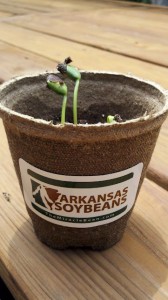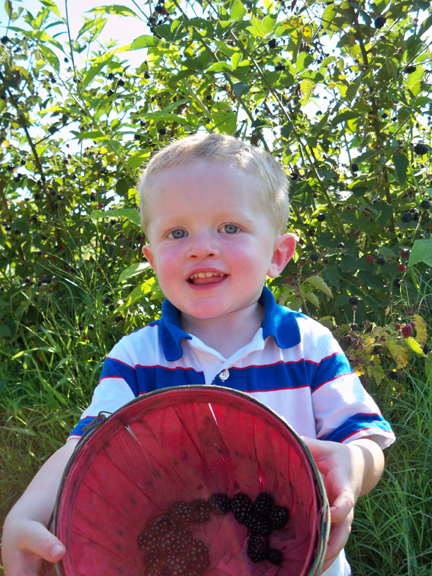Instead of the Dishes » Arkansas, Around the House, Go Green, Grocery Shopping, Health, Health & Fitness, Mommyhood » Soy 101: Soy as Food #Bean2Blog – Part Two
Soy 101: Soy as Food #Bean2Blog – Part Two

Our Bean2Blog Lunch - Soy Succotash, Baked Potato w/ Spicy Tofu topping, Pork Loin braised in soy oil.
So, did you take a gander at some of the other blog posts I linked to in part 1 of this Bean2Blog series? If you did, you saw that our time at Moss Mountain Farm was beautiful, busy, and very educational. Knowing that the event centered around soybeans, I was a little apprehensive about what would be presented to us. If you’ve read my past posts like this or this, you might know that I am a little on the “obsessive” side when it comes to food stuffs. I think it’s important to know what’s in our food, where it comes from, and why we should/shouldn’t be eating it.
I am not an expert in soy, but I have done a bit of research. I first starting paying attention to soy after I watched the documentary, Food Inc, which chronicles our corporate-based food supply system. I’ve said it before – if you haven’t watched Food Inc, you should. One segment of the film covers soy production in the US and what chemical companies like Monsanto and Pioneer are doing to our crops and the farmers who grow them. When it comes to growing methods for soy, there are three main categories:
- Organic – organic soy is pretty straight forward. No chemicals, no “bio engineering”. Just soybeans, grown with sun and water. This is definitely your safest option for eating, although there are still some concerns with how much soy you should eat because all soy naturally contains phytoestrogens (see below).
- Non-GMO – GMO stands for Genetically Modified Organism. So, a non-GMO soybean is one that has not been genetically modified. This does not mean it is organic – the seeds and plants are still treated with chemicals to improve crop yields by keeping weeds and pests at bay. Think of non-GMO soy as the middle ground when it comes to consumption.
- GMO – GMO soy has been genetically modified. You’ll also hear GMO soy called “bio-engineered” or “hybrid”. The most common example of GMO in soy is Monsanto’s “roundup-ready” beans, which are genetically altered to be more tolerant of Monsanto’s own herbicide, Roundup. Roundup will kill non-GMO and organic soybean plants, but GMO plants live through this chemical treatment. This allows farmers to produce a high-yeild, uniform quality crop that requires less time to maintain.
At the Bean2Blog event, I was able to speak one-on-one with both Jim Carroll, a 4th generation farmer from Brinkley and member of the Arkansas Soybean Promotion Board and the United Soybean Board (federal level), and Todd Allen, Chairman of the Arkansas Soybean Promotion Board. Both of these gentlemen were very gracious in answering my questions about soybeans in Arkansas. I spoke with Mr. Allen about what types of soy are being grown in Arkansas. I had already read this Pew Report stating that in 2001 60% of Arkansas’ soy crop was GMO. By 2004 92% was GMO. Mr. Allen said that he believes that 95% of Arkansas soy is GMO now, and he did not know of any organic soy being grown in the state. Mr. Carroll does grow some Non-GMO soy on his farm, but the majority of his crop is GMO. According to Carroll, he can make more money off of GMO soy and it is easier to sell, so it’s difficult to dedicate land to the less-lucrative Non-GMO crop. However, both men told me that they are starting to see problems with Roundup tolerant weeds in their GMO crops. This development could lead to either an increase in Non-GMO crop, or development of new “chemistry” to replace Roundup as a herbicide.
So, if you’re like me and aren’t really keen on feeding your family food that’s been genetically altered and bathed in chemicals, there are some glimmers of hope. In addition to Food Inc, the recent. uproar over Kashi using GMO soy in their “natural” cereal products has added to the awareness level of the general population. While media stir-ups such as this may not be entirely fair to the company, they certainly increase demand for non-GMO and organic food products. Here in Arkansas, the first plant dedicated to the receiving, processing, packaging and shipping of edamame, (a type of soybean) which will be grown by Arkansas farmers, will be constructed this year in Mullberry. Allen said the edamame crop will be entirely non-GMO. In addition, Arkansas-based Riceland, (yes, the rice company) is considering growing non-GMO soy, according to Allen.

Rhonda Caroll demonstrated a machine used to make soy milk in poverty stricken areas - works in your kitchen too!
Now, to throw one more consideration at you – those phytoestrogens. Phytoestrogens occur naturally in some plants, most potently in soybeans. There’s a lot of controversy going on over this little micronutrient. Essentially, you’re dealing with a natural hormone. So, there are some studies (and speculation) that increased consumption of soy could lead to hormonal imbalances and things like stirility and breast cancer. On the other hand, some folks think that soy might help with menopausal symptoms. My own doctor, who maintains a vegan diet, told me that she and her husband are restricting their children’s intake of soy based on the extensive research they have done. Personally, I have increased soy in my diet intentionally in an attempt to try to balance out my hormones after I quit taking birth control. My kids eat soy products in moderation, and organic soy milk is part of our almond-soy-cow-coconut milk rotation.
During our talk, Mr. Caroll pointed out to me that soy is a powerful crop in that it can be easily transported to areas where people don’t have access to food, and it only takes a small amount of soybeans to provide the protein that those people need to survive. He said that in order to produce enough food to meet the needs of our planet, the most efficient farming methods have to be used. I absolutely agree with Caroll. When it comes to hunger, anything we can do to close the gap between production and consumption is a good thing. We are priviledged here in the US to have choices about what we consume and how we consume it. Caroll also gave me a good reminder – soy is not the only crop that is heavily GMO. Corn and many other vegetables are being manipulated too.
I hope that this post gives you the basics you need to start your own education on how soy best fits into your family’s lifestyle. Soy has benefits that stretch beyond its edibility. Tomorrow I’ll share some of those with you!
Filed under: Arkansas, Around the House, Go Green, Grocery Shopping, Health, Health & Fitness, Mommyhood · Tags: arkansas, bean2blog, GMO, non-GMO, organic, phytoestrogen, Soy

















